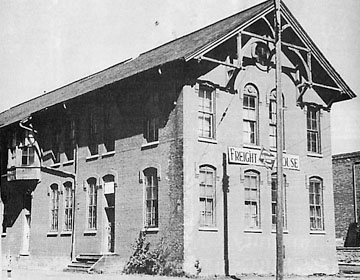Fargo and Southern Railroad

Wishing to reduce freight charges, 23 Fargo business pooled $100,000 in 1881 to build a railroad line from Fargo south to Ortonville, Minnesota (117 miles away) where they planned to link with the Milwaukee Road. Construction of the line began in 1883. Working without an engine, ties and rails had to be hauled with a handcart. As the line extended, this became a laborious task. One story tells of a time when the Fargo and Southern crew "borrowed" an engine from the Northern Pacific while its train crew were at dinner. The Fargo and Southern crew reportedly hauled their material to the end of their track and returned the NP engine before it was even missed!
The first official Fargo and Southern train ran on the evening of July 2, 1884. The first passenger train ran on August 17. Within a few months, the railroad was running two passenger trains daily and had built a brick depot (pictured right) at Second Avenue and 11th Street north. They also built a freight depot two blocks west at 13th Street.
Just as the Northern pacific established Fargo, so did the Fargo and Southern establish Abercrombie and Wheaton in 1884. In fact, Wheaton was named in honor of Daniel Thomas Wheaton, the civil engineer and county surveyor who did the original plat work for the Fargo and Southern Railroad.
The railroad was short-lived, however. Bowing to financial pressures, H.E. Sargent, President of the Fargo and Southern (who lived in Chicago) sold the line to the Chicago,Milwaukee, and St. Paul Railroad (later known as the Milwaukee Road). The last solely passenger train left the depot on December 7, 1931. The railroad continued mixed operations (passenger and freight) until October 31, 1956, when all passenger service was stopped. The passenger depot became a freight depot at that time. In December 1961, the depot was essentially abandoned as the Milwaukee Railroad modernized their office and freight operations.
Jack Akre began to bought the building in September 1970 with plans to restore the building and lease space to small businesses. The building was known as the "Depo." In December 1974 a fire ended Mr. Akre's plans and the building was once again virtually abandoned. Will Hoglund of Tochi Products purchased the building in 1978 and began to reuse it.
